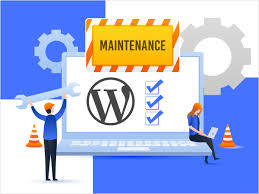WordPress Website Maintenance Checklist: Keeping Your Site in Top Shape
Is your WordPress website running as smoothly as it should be, or are minor issues starting to pile up and affect performance? Regular maintenance, a straightforward process, ensures your site remains secure, fast, and user-friendly. Without proper care, even the most well-designed website with the latest functionality, such as requesting a quote for WooCommerce, can encounter problems that disrupt user experience and impact your online presence. This guide, a comprehensive checklist, provides you with the reassurance and confidence to maintain your WordPress site, covering everything from regular backups to optimizing performance. By following these steps, you can keep your website in top shape and avoid the common pitfalls that plague neglected sites.

- Regular Backups
First and foremost, regular backups are essential. A backup can save your site from data loss due to hacking, server crashes, or human error. Use plugins like Updraft Plus, BackupBuddy, or Jetpack to automate the backup process. Ensure backups are stored offsite, such as on cloud storage services like Google Drive or Dropbox. Regularly test your backups to confirm they are complete and can be restored without issues.
- Update WordPress Core
Keeping the WordPress core updated is vital for Security and functionality. Updates often include patches for security vulnerabilities, new features, and performance improvements. Regularly check for updates in your WordPress dashboard and apply them as soon as they are available. Consider enabling automatic updates for minor releases while handling major updates manually to ensure compatibility with themes and plugins.
- Update Themes and Plugins
Themes and plugins are the backbone of your site’s functionality and design. However, keeping them updated is not a chore, it’s a necessity. Outdated themes and plugins can pose security risks and cause compatibility issues. So, regularly check for updates and apply them promptly. Before updating, ensure you have a recent backup and read the change logs to understand what has been updated. To avoid potential disruptions, use a staging site to test updates before applying them to your live site.
- Delete Unused Themes and Plugins
Only themes and plugins can slow down your site and increase security vulwnerabilities. Regularly review your installed themes and plugins and delete those you no longer use. This reduces the attack surface for hackers and helps improve your site’s performance. Remember to deactivate a theme or plugin to avoid potential issues before deleting it.
- Optimize Database
A cluttered database can slow down your site. Regularly optimize your WordPress database to remove unnecessary data such as spam comments, post revisions, and transient options. Plugins like WP-Optimize and WP-Sweep can help automate this process. Additionally, consider using a database cleanup tool to identify and remove unused tables left by deleted plugins.
- Monitor Security
Website security is paramount. Use security plugins like Wordfence, Sucuri, or iThemes Security to monitor your site for malicious activity. These plugins offer features like malware scanning, firewall protection, and login security. Regularly review your security logs for any suspicious activity and take immediate action if you find any issues. Ensure your hosting provider offers robust security measures and keep your server software updated.
- Check for Broken Links
Broken links can negatively impact user experience and SEO. Regularly scan your site for broken links using tools like Broken Link Checker or online services like Dead Link Checker. Fix or remove any broken links you find to ensure your site remains user-friendly and maintains its search engine rankings. Review your internal and external links to ensure they point to relevant and up-to-date content.
- Test Website Speed
Website speed is not just a number, it’s a crucial factor for user experience and SEO. Use tools like Google PageSpeed Insights, GTmetrix, or Pingdom to regularly test your site’s speed. These tools analyze your site’s performance and provide recommendations for improvement. Identify and address any performance issues such as large image files, unoptimized code, or slow server response times. Consider using a content delivery network (CDN) to improve loading times for users across different geographical locations.
- Optimize Images
Large image files can slow down your site. Regularly optimize your images to reduce their file size without compromising quality. Use plugins like Smush, ShortPixel, or Imagify to automate image optimization. Additionally, consider using modern image formats like WebP for better compression and performance. Ensure your images are correctly sized and compressed before uploading them to your site.
- Check Mobile Responsiveness
A significant portion of web traffic comes from mobile devices. Ensure your site is mobile-friendly by regularly testing it on various devices and screen sizes. Use tools like Google Mobile-Friendly Test to identify and fix mobile usability issues. Optimize your site’s design, layout, and content to provide a seamless experience for mobile users.
- Review Analytics
Regularly reviewing your website analytics can provide valuable insights into your site’s performance and user behaviour. Tools like Google Analytics monitor traffic, bounce, and conversion rates. Analyze this data to identify areas for improvement and make data-driven decisions to enhance your site’s performance and user experience. Set up regular reporting to keep track of critical metrics and trends over time.
- Perform Regular Audits
Conducting regular audits of your website helps identify areas for improvement and ensures everything is running smoothly. Review your site’s content, design, and functionality to identify any issues or outdated elements. Perform SEO audits to ensure your site is optimized for search engines and follows best practices. Use tools like Screaming Frog or Ahrefs to assist with your audits and identify areas for improvement.
- Ensure Legal Compliance
Ensure your website complies with legal requirements such as GDPR, CCPA, or other data protection regulations. Regularly review your privacy policy, terms of service, and cookie consent to ensure they are up-to-date and compliant. Use plugins like WP Legal Pages or Cookie Notice to help manage legal compliance on your site. Stay informed about changes in legal requirements and update your site accordingly.
- Regularly Review Hosting
Your hosting provider is crucial to your site’s performance and Security. Regularly review your hosting plan to ensure it meets your site’s needs. Consider upgrading your hosting plan if you experience increased traffic or performance issues. Ensure your hosting provider offers features like regular backups, SSL certificates, and robust security measures. If needed, consider switching to a more reliable hosting provider.
- Maintain a Clean Codebase
Keeping your site’s codebase clean and well-organized helps improve performance and maintainability. Review and clean up your site’s code regularly by removing unnecessary or outdated code. Follow best practices for coding and ensure your code is well-documented. Use tools like PHP CodeSniffer or ESLint to identify and fix coding issues. Consider using a version control system like Git to manage code changes and collaborate with other developers.
- Stay Informed
The WordPress ecosystem is constantly evolving. Follow WordPress blogs, forums, and news sites to stay informed about the latest updates, trends, and best practices. Join WordPress communities and attend meetups or conferences to network with other professionals and learn from their experiences. Staying informed helps you keep your site up-to-date and ensures you are following best practices.
Conclusion
Regular maintenance is essential for the health and success of your WordPress website. Following a comprehensive maintenance checklist ensures that your site remains secure, fast, and user-friendly. Investing time in regular updates, backups, and performance optimizations can prevent issues before they arise and keep your website running smoothly. Remember, a well-maintained website enhances user experience and boosts your online presence and credibility. Stay proactive, and your WordPress site will continue to serve your visitors effectively and efficiently.
